
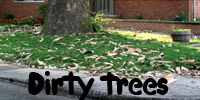
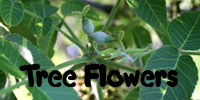
|
Welcome
to bobklips.com, the website of Bob Klips, a plant enthusiast living in
Columbus, Ohio.
Fall's
Final Flower, a Few Fresh Fruits, and a Fern.
(American
witch-hazel, several shrubs, and spinulose woodfern)
Hawk Mountain, Kempton, Berks County, PA.
September 20, 2008
Hawk Mountain panorama. September 20, 2008.
Hawk Mountain Sanctuary
is a several thousand acre nature sanctuary situated along an
Appalachian ridge in eastern Pennsylvania --the
Kittatinny Ridge, or Blue Mountain. The Appalachian Trail runs through
the preserve. From September through November, Hawk Mountain is one of
the best places in North America
to view the annual raptor migration.
The soil is thin and sandy. Before blight killed the trees in the early
20th century, American chestnut (Castanea dentata,
family Fagaceae) was predominant. Today, chestnut occurs only as
scattered stump sprouts that succumb to the blight when they
attain a diameter of a few inches.
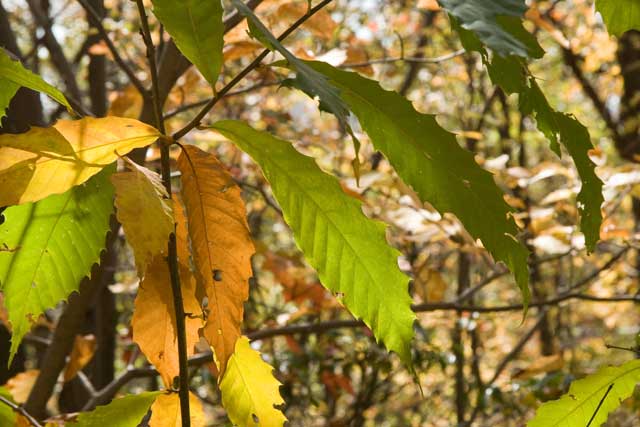
American chestnut, Hawk Mountain, PA. October 20, 2008.
Occasionally, an
American chestnut sprout
stays alive long enough to set fruit. The picture
below is a
fruiting tree that I photographed here last year.
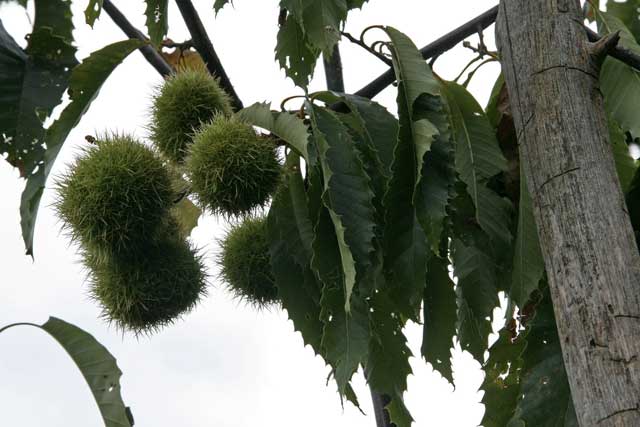
American chestnut fruits, Hawk Mountain, PA., September 13, 2007.
A distinctive shrub of open areas is mountain-ash (Sorbus
americana, family Rosaceae). Its fruits are small apple-like
pomes that are eaten avidly by thrushes, blues jay, and cedar
waxwing.
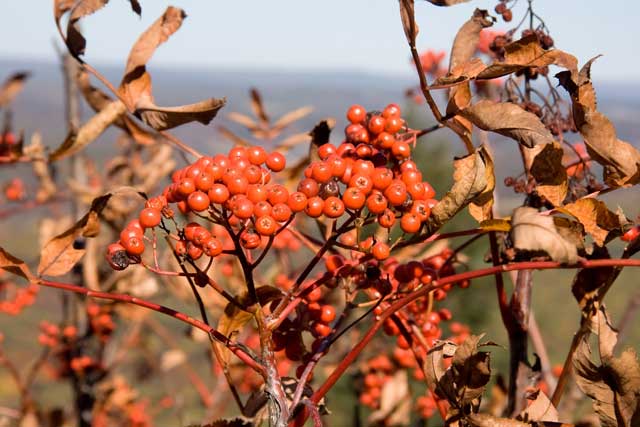
Mountain-ash in fruit. Hawk Mountain, PA. October 20, 2008.
The ridge is an acidic soil environment, which is a typical substrate
for members of the heath plant family, Ericaceae. Two such
heaths
are
evergreen shrubs: great rhododendron (Rhododendron maximum)
and mountain-laurel (Kalmia latifolia). Both are
fruting now; the fruits are dry, many-seeded "capsules."
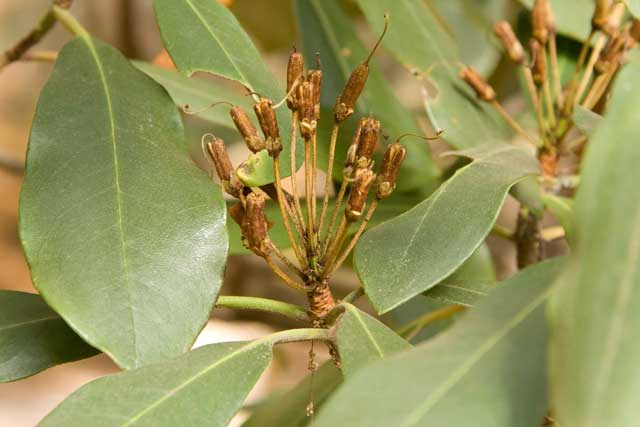
Great rhododendron fruits. Hawk Mountain Sanctuary, Kempton, PA.
September 20, 2008.
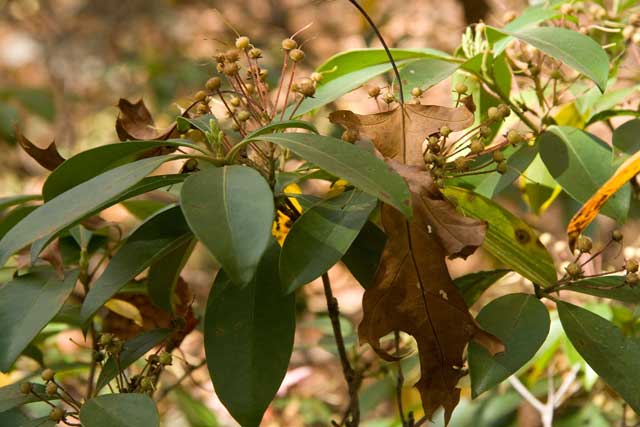
Mountain laurel fruits. Hawk Mountain Sanctuary, Kempton, PA. September
20, 2008.
A very late flowering shrub is American witch-hazel, Hamamelis
virginiana
(family Hamamelidaceae). It bears small axillary clusters
of greenish-yellow flowers that have very long, thin petals. Why is it
called witch-hazel? Perhaps because its branches have a reputation for
being well suited for fabricating dowsing-rods used to find
underground water, an activity regarded as a mild form of witchcraft. A
watery ointment made from its leaves and bark is a well-known,
widely available herbal remedy used for drying and cleansing skin.
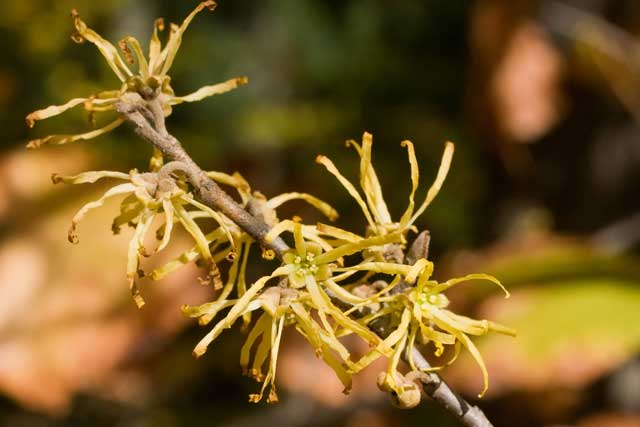
Amercan witch-hazel flowers, Hawk Mountain, PA. October 20, 2008.
Spinulose woodfern (Dryopteris
carthusiana),
family Dryopteridaceae) is an especially abundant woodland fern
that sometimes forms large colonies. It ocassionally occurs in
more open areas, where it might be mistaken for other ferns with lacy
leaf dissection, such as hayscented fern.
Spinulose woodfern,
Hawk Mountain Sanctuary, Kempton, PA. October 20,
2008.
Like most ferns, the
woodferns develop
"sori": clusters of spore-cases on the undersides of otherwise
normal appearing leaves. They are useful in identification, but
sometimes they are absent. Thus, for a fern enthusiast working on a
tricky identification who is hoping to see these things, the underside
of a fern leaf can be a sight for sore eyes!
Spinulose woodfern
sori at Hawk Mountain Sanctuary. October 20, 2008.
Milkweed bugs
OSU at Marion Campus Prairie
October 16, 2006
The word "bug" is used
in an informal
sense to mean any crawling little invertebrate, but among entomologists
the word is used in a more restricted sense, referring to any member of
the insect order Hemiptera. These are insects with
piercing-sucking
mouthparts, gradual metamorphosis, and front wings that are in part
leathery and in part membraneous. Both predaceous and herbivorous bugs
occur. An especially beautiful and intriguing hemipteran is the
milkweed bug, which feeds on seeds of milkweeds. Like milkweed beetles
and monarch butterflies (which also feed on milkweeds), these bugs are
brightly colored. Here are two individuals seen feeding at the
OSU-Marion Prairie.
Wow! In "swing state" Ohio, it seems like politics is everywhere!
Milkweed
bugs feeding on common milkweed. October
16, 2008. Marion, Ohio.
Especially Abundant Asters (and a
spear-scale)
Pleasant Township Park, Marion Ohio
October 2, 2008
During early and
mid-autumn, fields and roadsides
in the northeastern US and adjacent Canada are blanketed
by spectacular flowering displays consisting mainly
of
certain perennnial members of the aster family. These are goldenrods
(genus Solidago) and asters (until recently
classified in the genus Aster, but now that Aster
is regarded as restricted to the Old World, most of our asters are
classified as Symphyotrichum species).
Pleasant Township Park is a recently acquired nature preserve in
Pleasant, Marion County, Ohio. Here's an aerial photo showing the
approximate park boundary.
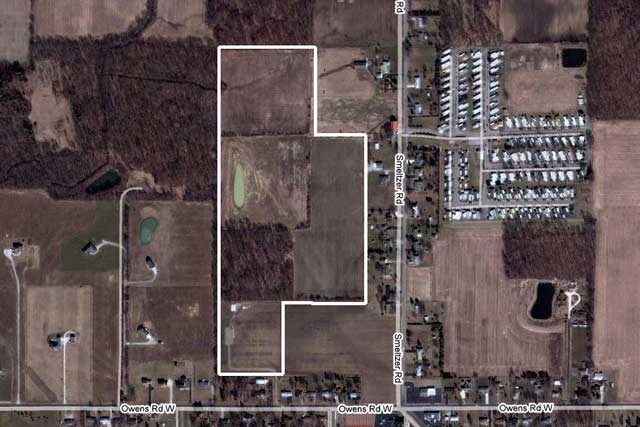
Pleasant Township Park, Marion Ohio (image courtesy of Google Maps)
Just north of the woods
there is a an open
meadow that was planted with prairie seeds, but it also includes many
plants that became established there naturally, such as goldenrod and
asters.
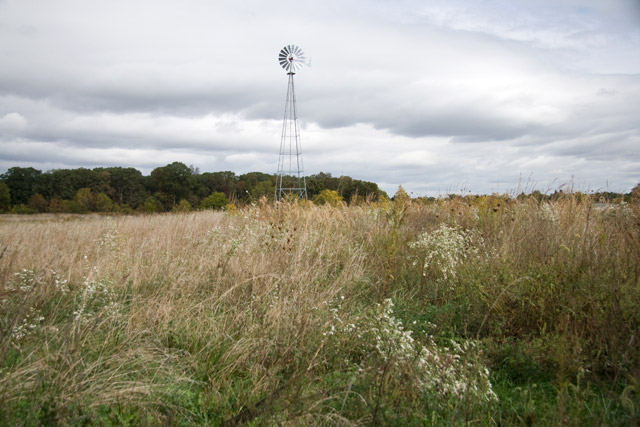
Meadow at Pleasant Park. October 2, 2008.
Our most common goldenrod is Canada goldenrod, distinguished by its
upright clonal growth, arching elm-like flowering branches, slightly
hairy stem, and narrow triple-nerved leaves.
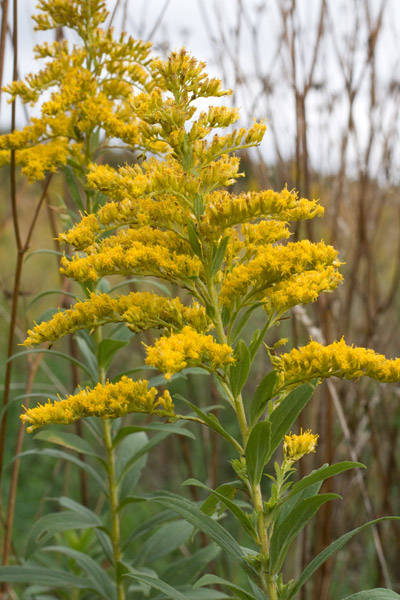
Canada goldenrod, Pleasant Township Park
Marion, Ohio. October 2, 2008.
The most conspicuous
aster is New England aster, Symphyotrichum novae-angliae,
distinguished by it purple ray flowers and yellow disk flowers.
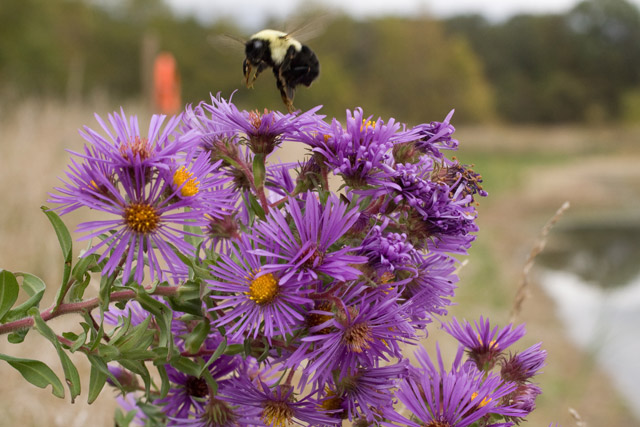
A confusing group of
asters are the small-flowered white ones, of which the eastern lined
aster (Symphyotrichum lanceolatus) is abundant here.
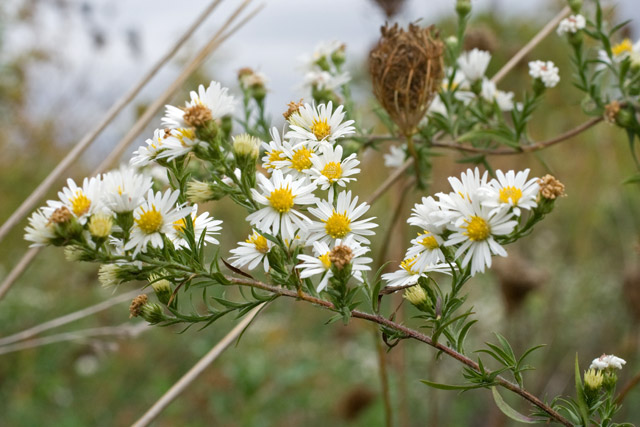
Eastern lined aster. Pleasant Park, Marion County, Ohio. October 2,
2008.
The goosefoot family
Chenopodiaceae includes herbs with small greenish flowers.
Spear-scales (genus Atriplex)
have flat paired bracteoles enveloping the small single-seeded fruits
(achenes). They are associated with saline or alkaline soil (although
this site isn't especially so).
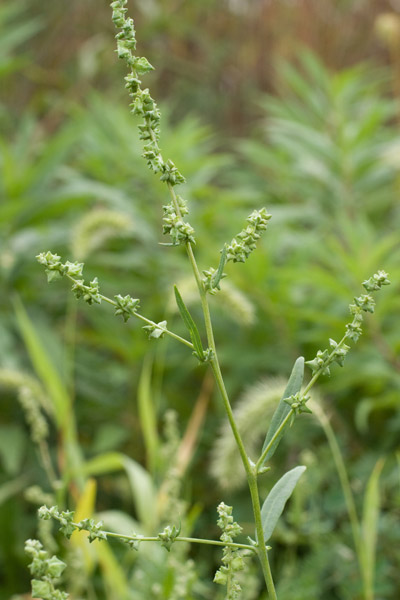
Spear-scale at Pleasant Park.
October 2, 2008.
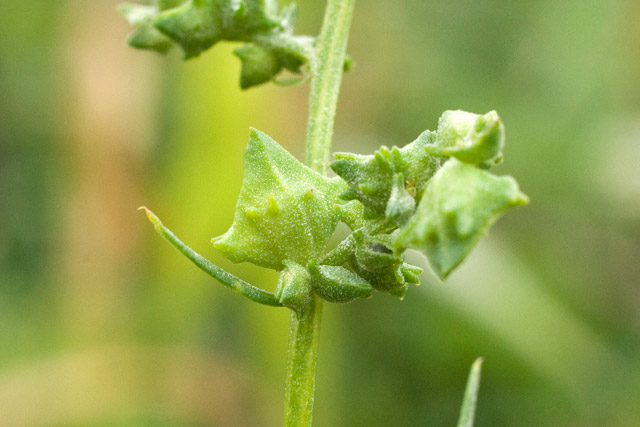
Fruits of spear-scale at Pleasant Park, Marion County, Ohio. October 2,
2008.
Castalia
Quarry Reserve
Erie County, Ohio
September 28, 2008
Castalia Quarry
Reserve. September 28, 2008.
The Wagner Quarries
Company Quarry #5 in
Castalia, Margaretta Township, Erie County, Ohio operated during two
time periods. The first was from
the
early 1870's until the economic hard times of 1929. During that period
it mainly provided large chunks of limestone used for
shoreline
riprap and general building purposes. Later, after laying idle for 25
years, quarrying resumed in the mid 1950's to provide stone
for
the
Ohio Turnpike, and continued in order to construct the bases
of
two bridges that cross
Sandusky Bay. Quarrying ceased presumably for good in 1965. Since then,
the area
has been allowed to revegetate and has become recognized as a
significant natural area with many interesting plants having an
affinity
for high-pH substrates. It is managed by Erie County Metroparks. We
visited the area in late September during the Ohio Moss and
Lichen
Assocation's Fall Foray
Somebody left behind a
couple of small scraps of metal.
Litterbugs! We thought about taking them home, but with all the moss
specimens and crisp fall apples from a nearby farm stand there
was
absolutely no room left in the trunk. Besides, how many stone
crushers
do you need?
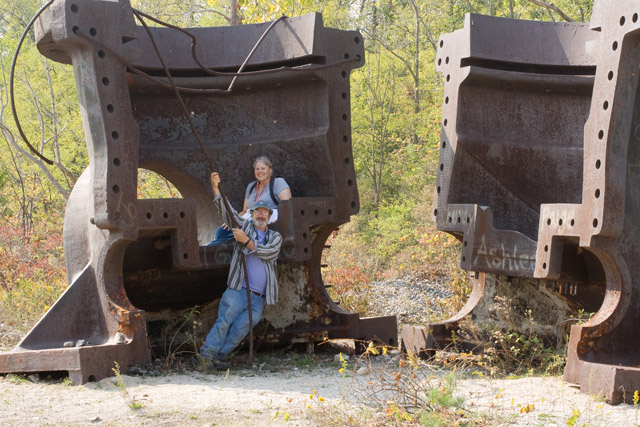
Portions of stone crusher at Castalia Quarry Reserve, Erie County,
Ohio. September 28, 2008.
The trees at the Quarry
are colonized by
some common, beautiful foliose macrolichens. One of them, a "speckled
shield lichen" in a genus recently segregated from Parmelia,
is Punctilia rudecta.
This lichen is large, gray, with crowded wavy lobes. Ray Showman and
Don Flenniken in their terrific "The Macrolichens of Ohio," tell
us this lichen is "very common in the eastern US on sunny
trees
and
rocks; one of the most common of Ohio's foliose lichens...this species
is moderately sensitive to air pollution and was previously impacted in
parts of northeastern Ohio. With the recently improved air quality, it
is recolonizing the area."
Puctilia
rudecta on tree trunk, Castalia Quarry, Erie County, Ohio.
September 28, 2008.
A similarly widespread and common lichen is Candelaria
concolor,
one of two "candleflame lichens" known from North America, both of
which are present in Ohio. It is a foliose lichen with
lobes so
very minute it could be mistaken for a crustose one. Ray and
Don
tell us C. concolor occurs on
bark exclusively.
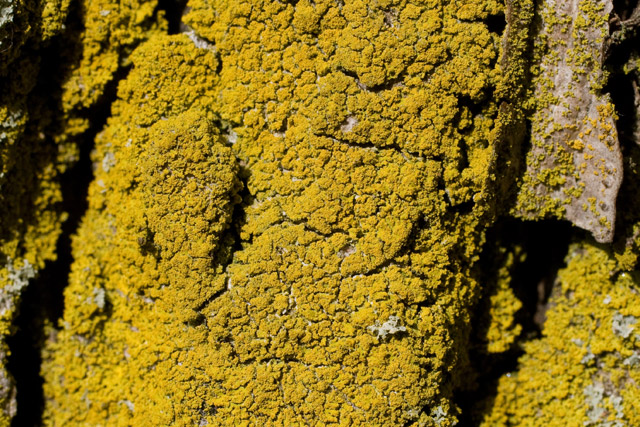
Candelaria conclor on tree trunk,
Castalia Quarry, Erie County, Ohio. September 28, 2008.
The limestone rocks
scattered on the
quarry floor have mosses growing on them. Two especially common ones,
both of which are pleurocarps (also called "carpet mosses," i.e.,
mosses that lay flat, are
repeatedly branched, and produce their sporophytes in the axils of the
branches), are Bryoandersonia illecebra (family
Brachytheciaceae) and Homomallium adnatum (family
Hypnaceae).
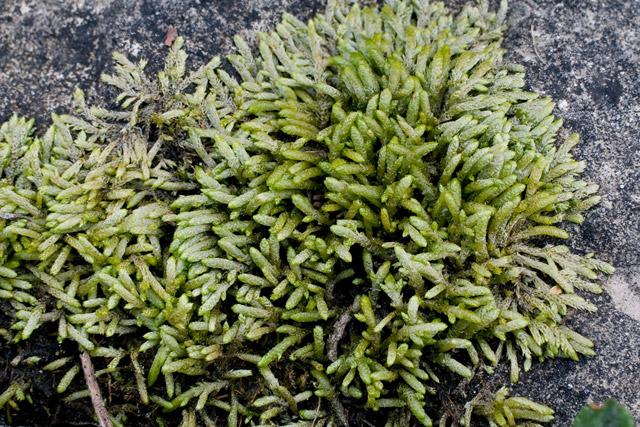
Bryoandersonia illecebra on rock, Castalia
Quarry, Erie County, Ohio. September 28, 2008.
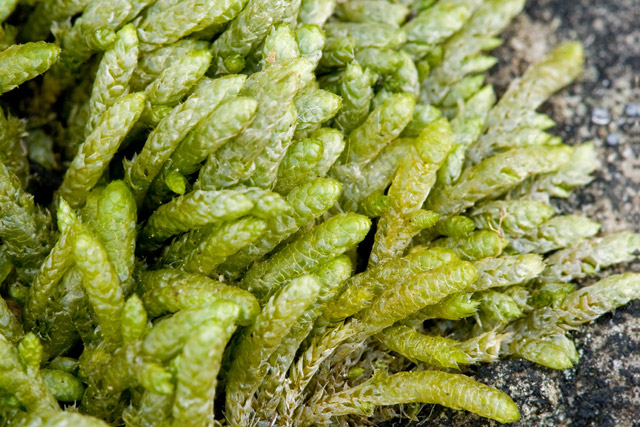
Closeup of Bryoandersonia
illecebra at Castalia
Quarry. September 28, 2008.
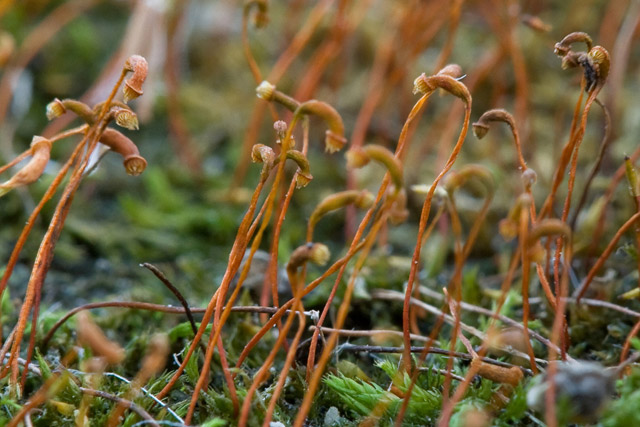
Homomallium adnatum on
rock, Castalia Quarry, Erie County, Ohio.
September 28, 2008.
Striking vascular
plants occur in the open
woods along the rim of the quarry. This time of the year sumac shrubs
present birds-eye-catching deep red panicles of many small
fruits
(drupes). Two similar species of sumac (Rhus)
are common, differentiated by the
presence or absence of hair on their stems. Staghorn sumac (Rhus
typhina) grows at the quarry, while smooth
sumac (R. glabra)
was seen
the previous day at Edison Woods, also in Erie County. Sumac
fruiting clusters can be immersed in cold water to make
a lemonade-like drink that is pleasant, provided that a ton of
sugar is added.
Staghorn sumac at
Castalia Quarry, Erie County, Ohio. September 28, 2008.
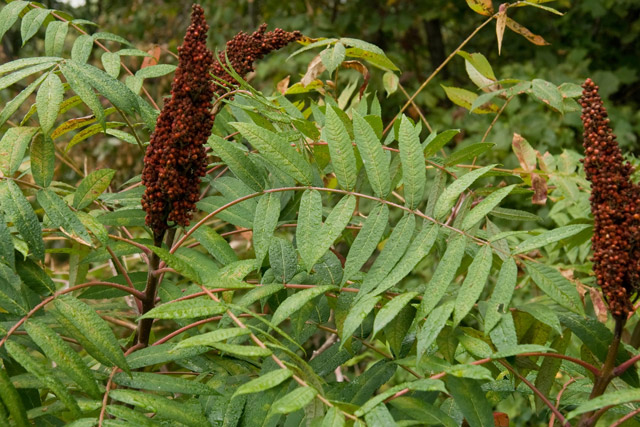
Smooth sumac at Edison Woods, Erie County, Ohio. September 27, 2008.
The rim of the quarry
is sparsely
vegetated with a variety of herbaceous plants, including some
interesting calciphiles. An uncommon goldenrod seen growing in low
moist spots, and a species sometimes found in
calcareous fens, is Ohio goldenrod, Solidago ohioense.
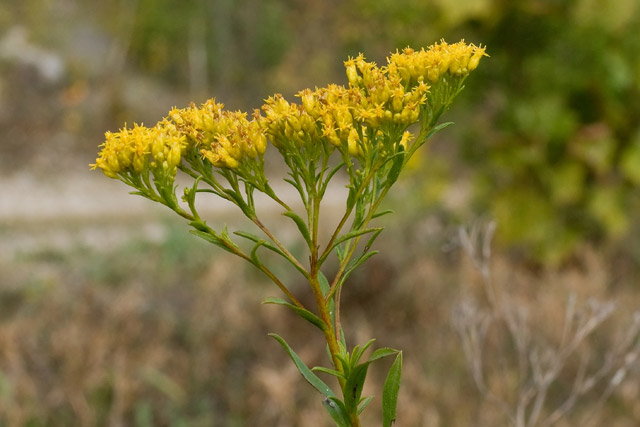
Ohio goldenrod at Castalia Quarry, Erie County, Ohio. September 28,
2008.
Several other, more
generally widespread goldenrods goldenrods are conspicuous,
including gray goldenrod, Solidago nemoralis,
and blue-stemmed goldenrod, S. caesia. Gray
goldenrod is typically found in dry open fields, while blue-stemmed is
more of a woodland species.
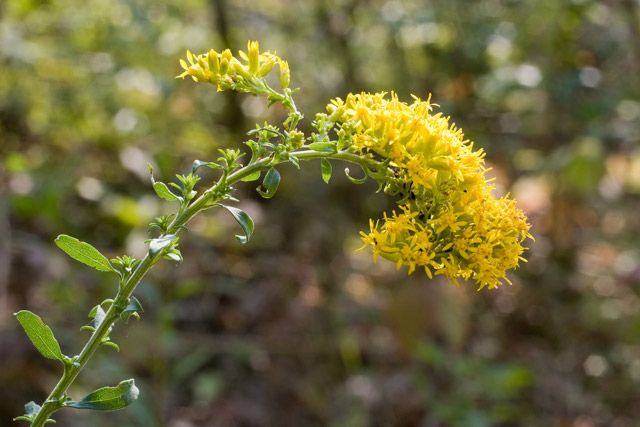
Gray goldenrod at Castalia Quarry, Erie County, Ohio. September 28,
2008.
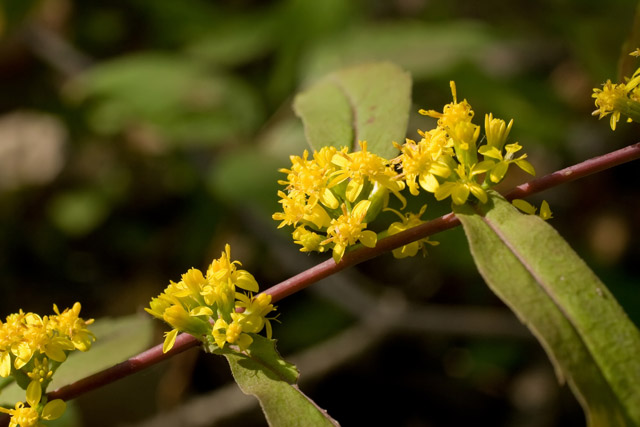
Blue-stemmed goldenrod at Castalia Quarry,
Erie County, Ohio. September 28, 2008.
Nodding ladies'-tresses is a fairly low-growing orchid growing on
patches of thin soil over a mid-level plateau area of the quarry, along
with with other herbs.
Nodding
ladies'-tresses at Castalia Quarry, Erie County, Ohio. September 28,
2008.
The mint family
(Lamiaceae) is one of our
most distinctive ones, consisting of herbs with square stems and
opposite leaves, and bearing two-lipped bilaterally symmetric flowers
with fused petals often arrayed in tight spike-like or globular
clusters tucked in the axils of reduced leaves. An inconspicuous, and
strikingly non- mint-like mint is a little annual found in open areas
that is comparatively few-flowered and has corolla lobes that are are
nearly equal, False pennyroyal (Isanthus brachiatus).
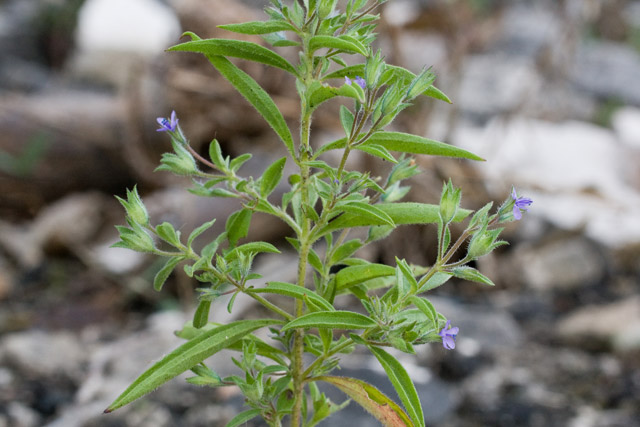
False pennyroyal at Castalia Quarry, Erie
County, Ohio. September 28, 2008.
One clue to false
pennyroyal's mebership in the Lamiaceae is the deeply 4-lobed ovary
that eventually matures into 4 little
nutlets. This is evident in the recently dehisced flower (now a young
fruit) in the
foreground.
False pennyroyal at
Castalia Quarry, Erie County, Ohio. September 28, 2008.
Goldie's
fern and butternut.
Edison Woods, Erie County, Ohio.
September 27, 2008.
Edison Woods is a 1,300 acre
nature preserve that
includes woodland, wetlands, and meadows. Because it
encompasses the
headwaters of Old Woman Creek, it safeguards water quality in that
important estuary.
From 1991 until 2001, Erie MetroParks leased the land from
Ohio
Edison Company, managing it as parkland with nature trails
for
the public. In 2001, the Trust for Public Land partnered with
the
City of Marion and Erie MetroParks to acquire funding to
purchase the land through Ohio
EPA's Water Resource Restoration Sponsor Program. Now it is permanently
protected, and still managed by Erie Metroparks.
The area is
traversed by an escarpment of Berea sandstone that comprises a
regionally unusual substrate type for mosses and lichens.
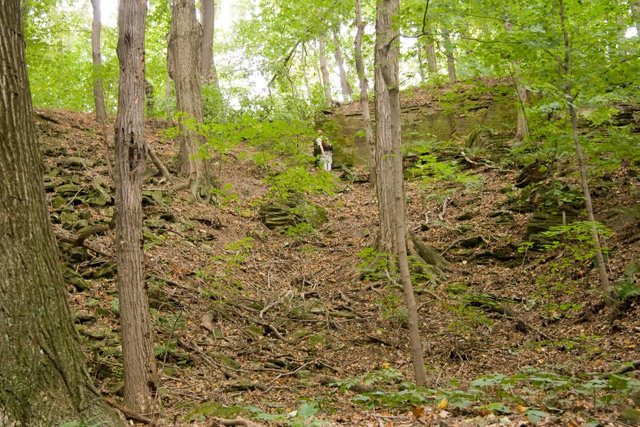
Sandstone escarpment at
Edison Woods, Erie County, Ohio. September 27, 2001.
One
of the more common mosses at Edison Woods and elsewhere in Ohio is a
log-inhabiting pleurocarp (carpet moss), Callicladium
haldanium (family Sematophyllaceae).
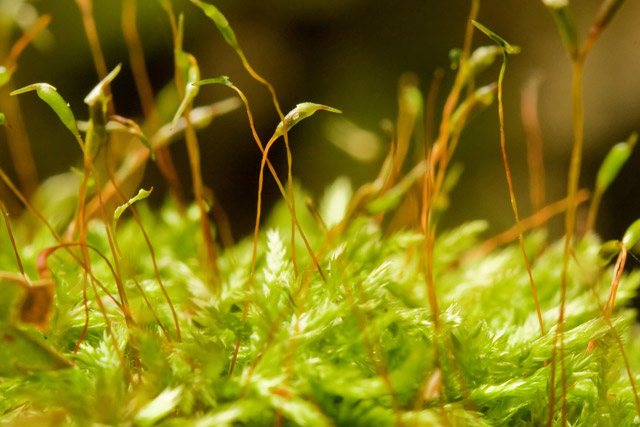
Callicladium haldanianum, a common moss found
carpeting decaying logs.
Edison Woods, Erie County, Ohio, September 27, 2008.
The woods is home to
two woodfern species that
are simliar in being somewhat leathery-leaved, with
bipinnate-pinnatifid (fernlike, bascially) leaf morphology, and a scaly
rachis (leafstalk). One of them, marginal woodfern (Dryopteris
marginalis) is quite common, while the other, Goldie's fern (D.
goldiana) is encountered much less often.
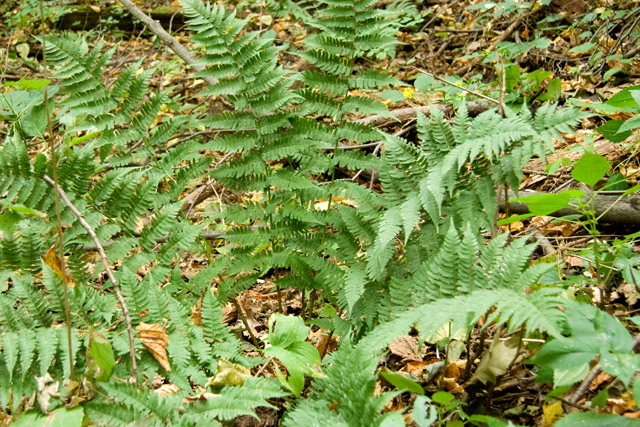
Marginal woodfern is medium-sized, with a proportionally short rachis
(leafstalk).
It has an upright rootstock, hence its leaves are arranged
in circular rosettes.
Edison Woods, Erie County, Ohio. September 27, 2008.
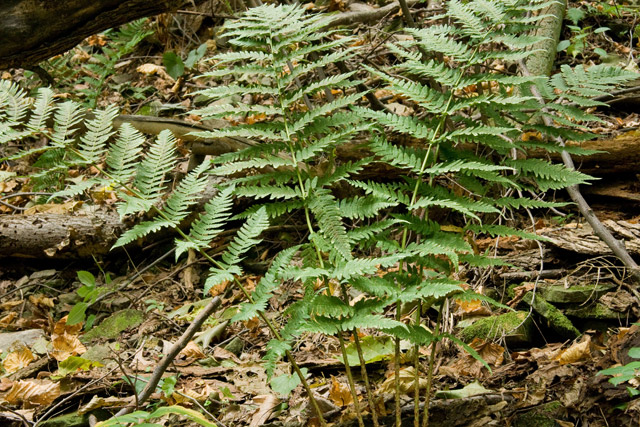 Goldie's fern is the giant of woodferns, with a
proportionally long rachis.
Goldie's fern is the giant of woodferns, with a
proportionally long rachis.
It has a somewhat creeping rootstock, hence its leaves are more widely
spaced than
those of marginal woodfern. Edison Woods, Erie
County, Ohio. September 27, 2008.
When these ferns
present sori
(clusters of tiny spore cases) on the undersurfaces of their leaves,
identification is made even clearer. The sori of marginal woodfern are
located just within the margin of the leaf (inframarginal),
whereas those of Goldy's fern are well within the area between the
margin and the midvein (inframedial).
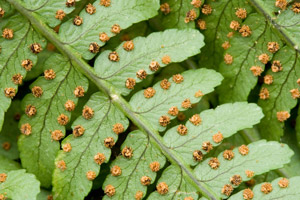 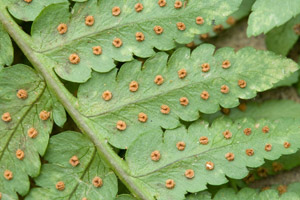
Woodfern sori. Left: infrarginal sori of D.
marginalis. Right: inframedial sori of D. Goldiana.
Edison Woods, Erie County, Ohio. September 27, 2008.
Butternut (Juglans
cinerea, family
Juglandaceae), also called "white walnut" is a beloved North American
hardwood tree that produces an easily worked light brown wood that is
prized
for carving and cabinetry. The the nuts are excellent food
for wildlife
and humans. It is a close relative of the very common black walnut (J.
nigra).
In much of its range, including Ohio, butternut populations are being
decimated by an exotic fungus disease called butternut canker, that
causes open sores (cankers) on stems.The cankers kill the stems and
ultimately the whole tree sucumbs. It was a special thrill to see a
mature butternut tree that bore fruits.
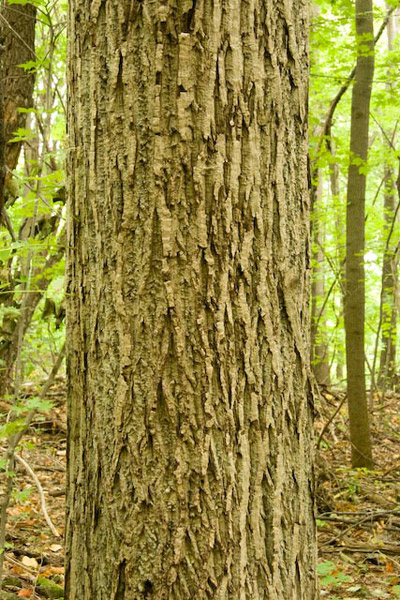
Trunk of fruit-bearing butternut tree.
Edison Woods, Erie County, Ohio.
September 27, 2008.
Butternuts are
similar to black walnuts, but they are ellipsoidal (black walnuts are
globose), and sticky.
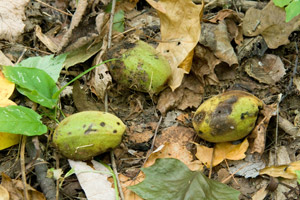 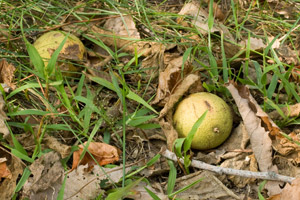
Juglans fruits.
Left: butternut (Edison Woods, Erie County, OH, September 17, 2008)
Right: black walnut
(Castalia Quarry, Erie County, OH, September 18, 2008)


Earlier
observations ("back")
|

